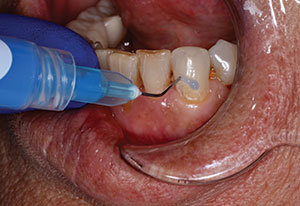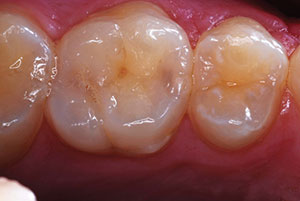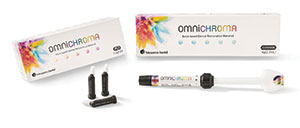INTRODUCTION
Choice is a wonderful thing, but what happens when you have too many choices? Usually, having too many choices leads to confusion and the inability to select just what you want or need. That is exactly what is happening in dentistry with bonding agents. The good news is that many of the bonding agents available work well. However, what are you using and why are using it are the important questions. With millions of bonded restorations being placed every year, what we need is dependable and predictable results for both direct and indirect restorations.
A Brief History of Bonding
Bonding agents have been classified according to “generations.” In the early days of bonding (1st and 2nd generations), from the 1960s to 1980s, dentin etching was frowned upon, resulting in weak bonding to the smear layer. In the 1980s (3rd generation), there was still no etching of the dentin and priming was added as a step, improving bond strength but still with marginal staining. By the early 1990s (4th generation), dentin was starting to be etched, a separate primer was used to develop a hybrid layer of dentin and collagen, and dentin was sealed. The steps were getting more complicated; however, higher bond strengths were being achieved.
In the mid 1990s, we started to see what we would consider the era of modern bonding (5th generation). The primer and adhesive was combined, making the technique a bit easier while providing high bond strengths. Yet, we were also seeing higher amounts of sensitivity. In the late 1990s, the 6th generation bonding agents with self-etching primers reduced sensitivity at the cost of lower enamel bond strengths. Then, in the late 2000s, the 7th generation bonding agents emerged, combining etch, primer, and bonding agent into one bottle, making for easy use, but in many cases, lowering enamel bond strengths.
Many dentists are confused about what is the best generation of bonding agents to use. Some dentists stay with the tried and true 5th generation bonding agents, using a total or self-etch technique to achieve high enamel bond strengths. Others pick and choose the bonding agent based on the procedure (for example, with porcelain veneers where there may be ample available enamel). The big switch is moving to the 6th and 7th generations, looking for limited sensitivity and ease of use.
Universal Bonding Agents
Currently, we now have another choice available: universal bonding agents. A few examples of different universal bonding agents are Futurabond U (VOCO America), OptiBond XTR (Kerr), Prelude One (Danville Materials), ALL-BOND UNIVERSAL (BISCO Dental Products), and Scotchbond Universal (3M ESPE).
These universal bonding agents would seem to be the answer to make the job of bonding easier. The problem with the name universal is that this term can be defined in different ways by various manufacturers. This means it is imperative that the dentist know exactly what the criteria are for using the bonding agent that is chosen. This is different from the one-size-fits-all approach to many products, where the clinician can choose among different techniques and manufacturers. The term universal may reference that the bonding agent can be used with different techniques such as self-etch (7th generation), selective-etch (etching of enamel only), or total-etch.
What about bonding to metal, or to high-strength all-ceramic materials such as lithium disilicate and zirconia? The good thing is, all of the universal bonding agents have a silane coupling agent, making the application of a separate primer to the all-ceramic restorative material unnecessary. Another concept of universal is the ability to be used with all light-cured, self-cured, or dual-cured composites.
Manufacturers’ Clinical Protocols
Futurabond U can be used for both direct and indirect restorations with self-, selective-, or total-etch techniques. Futurabond U can be used with light-, dual-, or self-cured composites, and with core build-up materials. It will bond with metal, zirconium or aluminum oxide, along with feldspathic porcelains and composite resins.
OptiBond XTR can be used on all direct and indirect restorations using a self-etch technique. There is no mention in the instructions about using a selective acid-etch since the material etches both cut and uncut enamel. So, should you use a separate etching step with Optibond XTR? The answer is probably no. Optibond XTR can be used with light-, dual-, and self-curing composite and core build-up material. It will bond with composites, metal, zirconium or aluminum oxide, along with feldspathic porcelains.
Prelude One is a light-curable, single-component, self-etch adhesive designed to bond composite resins to most dental surfaces. These surfaces include dentin, enamel, zirconia, alumina, metals, porcelain, lithium disilicate, and composite restorations. To enhance the bond, enamel may be selectively etched. As a universal adhesive, Prelude One is compatible with light-, dual-, and auto-cured composites.
ALL-BOND UNIVERSAL can be used for both direct and indirect restorations using either selective- or total- and self-etch techniques. ALL-BOND UNIVERSAL can be used with light-, dual-, and self-cured materials along with bonding to composites, zirconia, lithium disilicate, and metal.
Scotchbond Universal can be used with the total-, self-, or selective-etch techniques for both direct and indirect restorations. Scotchbond Universal will bond to all light- and dual-cured composites, metals, zirconia, and lithium disilicate. Furthermore, with the addition of the Scotchbond Universal DCA Dual Cure Activator, it will bond to resin cements.
How Do You Chose?
Again, these are just a few examples. As you can see, like most dental materials, they are comparable in their uses. So what criteria can you use in trying to choose the right bonding agent for you? The first thing to consider is, will they bond well? The answer is yes! You can look at the research, but one criterion is to see how these bonding agents adhere to all the substrates, dentin, cut and uncut enamel. Depending on the preparation, you may have more of one than the other, especially the uncut enamel. So if you were doing porcelain veneers, should you etch or self-etch? This is where the one-size-fits-all bonding agents will work, but not without some thought given to the procedure by the dentist. This is why it is imperative that the dentist read the clinical instructions for any new bonding agent prior to use.
Bonding agents show different bond strengths to different substrates, so be sure that you will attain your desired bond strength when placing your indirect restoration. Check with the manufacturer about the bond strengths to zirconia and lithium disilicate. Make sure that you prepare the surface of the indirect restoration according to the manufacturer’s instructions in order to attain the highest bond strengths.
Other Factors to Consider in Selecting a Bonding Agent
Another factor to consider is related to how these materials are dispensed. Do you choose the single application, where you will always get a freshly mixed material (such as Futurabond U or OptiBond XTR unidose), or the systems with more traditional dispensing bottle(s)? Some manufactures even tint the adhesive (such as Scotchbond Universal), which becomes a personal preference for the dentist as to whether this assists in the bonding procedure or not.
Time factors include whether the universal system is a one- or 2-step procedure. Do you need to apply a single layer (such as Futurabond U, Prelude One, or Scotchbond Universal)? Or, do you need 2 layers (such as ALL-BOND UNIVERSAL)? Some might require both priming and adhesive layers (such as OptiBond XTR).
Another factor is the strong odor that some of these adhesives can produce. Both doctors and patients do complain about this, but this has no bearing on the material’s ability to bond; it is strictly a patient relations concern.
Another issue may be curing time. This is very much dependent on the type and strength of your curing light. Read the recommendations for the proper curing time based on your curing light’s (measured and verified) output.
CASE 1
Using a Self-Etch, 7th Generation Bonding Agent with Selective-Etch
A 20-year-old female presented with incipient decay in enamel on the mandibular left first molar. Since she had a very low caries index, the decision was made to place a sealant (Figure 1). A 7th generation bonding agent (Prelude One) was chosen. The multiuse bottle was shaken, and then 2 drops were placed in a well. Per the instructions, to get higher enamel bond strengths, the recommended acid-etching was done. A 35% phosphoric acid was selectively placed on the enamel for 30 seconds (Figure 2). The acid gel was rinsed away, and the tooth was then very lightly dried with air (Figure 3).
A layer of Prelude One was scrubbed into the enamel for 20 seconds (Figure 4). The bonding agent was then air-dried for 5 seconds to evaporate the solvent, and then an additional 5 to 7 seconds until the material no longer moved. The bonding agent should appear glossy at this point. A Demi Ultra Curing Light (Kerr), with a minimum output of more than 1,000 mw/cm2, was used to light cure the adhesive for 10 seconds. The tooth was now ready to be restored with a direct composite. BEAUTIFIL Flow FO2 Composite (Shofu Dental) was allowed to flow into the grooves, then light cured. The occlusion was checked, adjusted, and the restoration polished (Figure 5).
| CASE 1 | ||||||||||
|
CASE 2
Using a Self-Etch 6th Generation Bonding Agent
A 28-year-old male presented with a defective amalgam restoration in the maxillary left first premolar (Figure 6). The patient was anesthetized and the amalgam removed (Figure 7). A Triodent sectional matrix and Triodent V3 Ring were placed (Figure 8). A 2-step universal adhesive, OptiBond XTR, was selected for this case. The OptiBond XTR primer was scrubbed onto the enamel and dentin for 20 seconds (Figure 9), then air-thinned for 5 seconds. The OptiBond XTR adhesive was then placed onto the enamel and dentin with a light brushing motion for 15 seconds, and then air-thinned with a medium pressure for 5 seconds. An additional interval of stronger air-drying was done for another 5 seconds. Next, the adhesive was light cured with a Demi Plus Curing Light. A single-bulk filling of the restoration was accomplished using SonicFill (Kerr) bulk fill composite (Figure 10). The restoration was light cured 20 seconds from the occlusal, then 10 seconds from both the buccal and palatal aspects. The matrix was removed and the occlusion was checked. Finally, the restoration was polished (Figures 11 to 13).
| CASE 2 | ||||||||||||||||
|
CASE 3
A Zirconia Crown Cementation Protocol
This series of photos demonstrates a technique to preparing a monolithic zirconia crown (BruxZir [Glidewell Laboratories]) for resin cementation.
After try-in, the inside of the zirconia crown was air abraded with PrepStart (Danville Materials) with 50 µm alumina oxide at 45 psi (Figure 14). Any excess powder was blown out with compressed air (Figure 15).
As an alternative procedure for the preparation of the internal surfaces of a zirconia restoration after try-in (knowing that the dental lab team’s usual protocol is to sandblast the internal aspects of the crown before delivery), simply apply a universal cleaning gel, such as Ivoclean [Ivoclar Vivadent]) for 20 seconds to the intaglio surfaces, then rinse thoroughly and dry with oil-free air.
The application of Futurabond U was mixed (Figures 16 to 19) and placed into the crown for 20 seconds. The crown was then air-dried for 5 seconds to remove the solvent, and then to thin the material. The bonding agent was then light cured for 10 seconds (Figure 20). A resin cement (Breeze [Pentron]) was dispensed into the crown and then the crown was placed into the mouth. Next, the margins were light cured for one second. The excess cement (in a gel state) was then removed with an explorer, then the remainder of the cement was allowed to cure for 4 minutes until fully set.
| CASE 3 | ||||||||||||||
|
CLOSING COMMENTS
All of the mentioned bonding agents will provide good bonding when used properly. Remember, although these bonding agents are universal in nature, there is still a need to read the manufacturers’ directions carefully since the instructions may vary for different clinical and material circumstances (such as when bonding direct and indirect restorations). As much as we would like these “universal” bonding agents to be as simple as possible, and although they are a step in the right direction to make procedures easier for clinicians, they are still not a one-size-fits-all solution.
Dr. Jablow received his dental degree from New Jersey Dental School in 1986 and practices in Woodbridge, NJ. He has achieved Fellowships from the AGD and the International Association of Dental-Facial Esthetics and holds memberships in the ADA, AGD, and NJ Dental Association. He is a long-time member of his county’s peer review committee and is also certified in various laser wavelengths. He is president of Dental Technology Solutions, a lecture and consulting company, and he writes a column for drbicuspid.com called “Ask Marty.” He is the host of Take 5 With Marty, an online dental video show. Consulting with various high technology companies, he is involved with the process of improving established products and testing new products and techniques. He consults with dental offices on implementing dental technology into their practices, and he enjoys promoting the use of technology in the dental office with an emphasis on improving patient care. Dr. Jablow can be reached at marty@dentaltechnologycoach.com or at (848) 207-4567.
Disclosure: Dr. Jablow lectures for Kerr, VOCO America, and Danville Materials, but did not receive compensation for writing this article.































